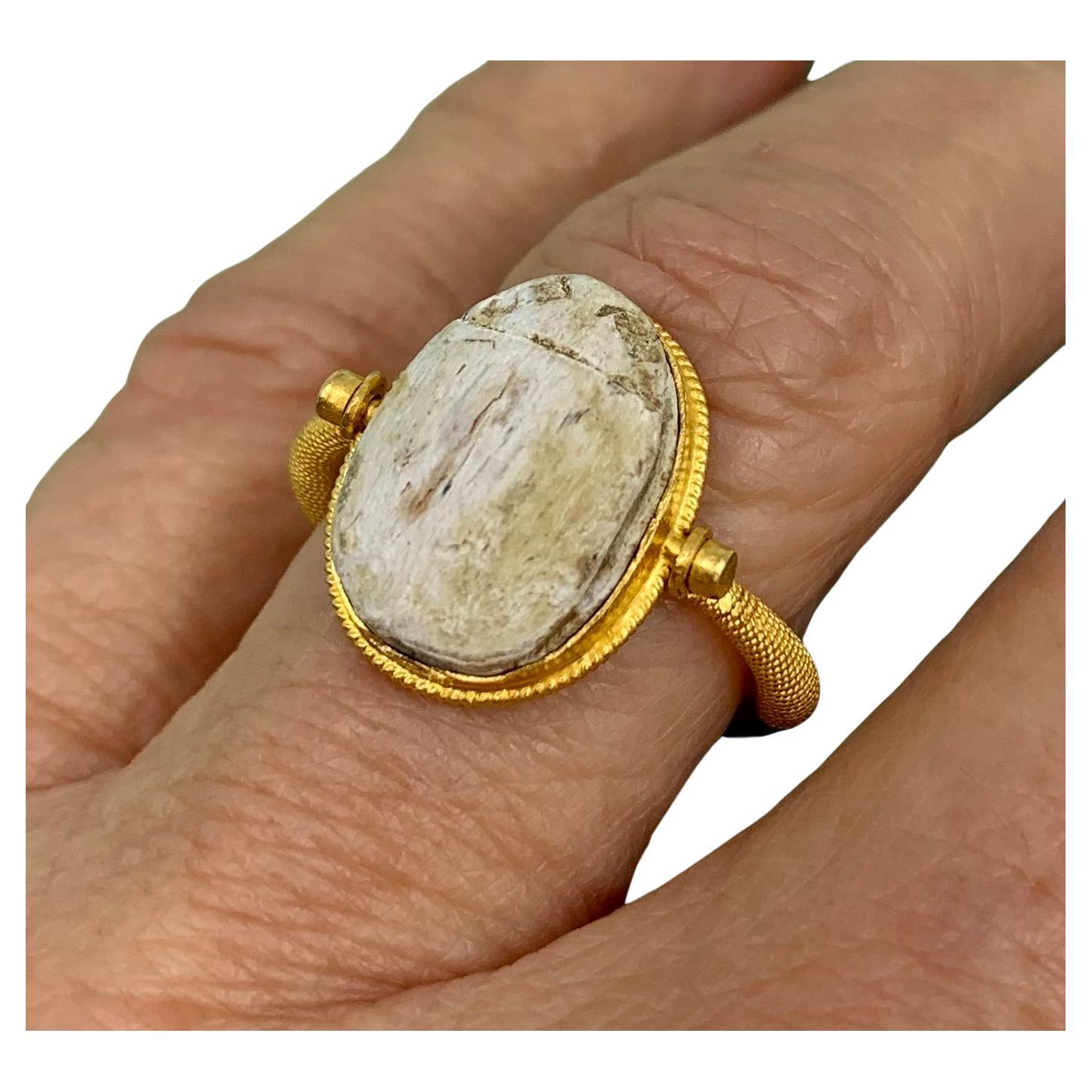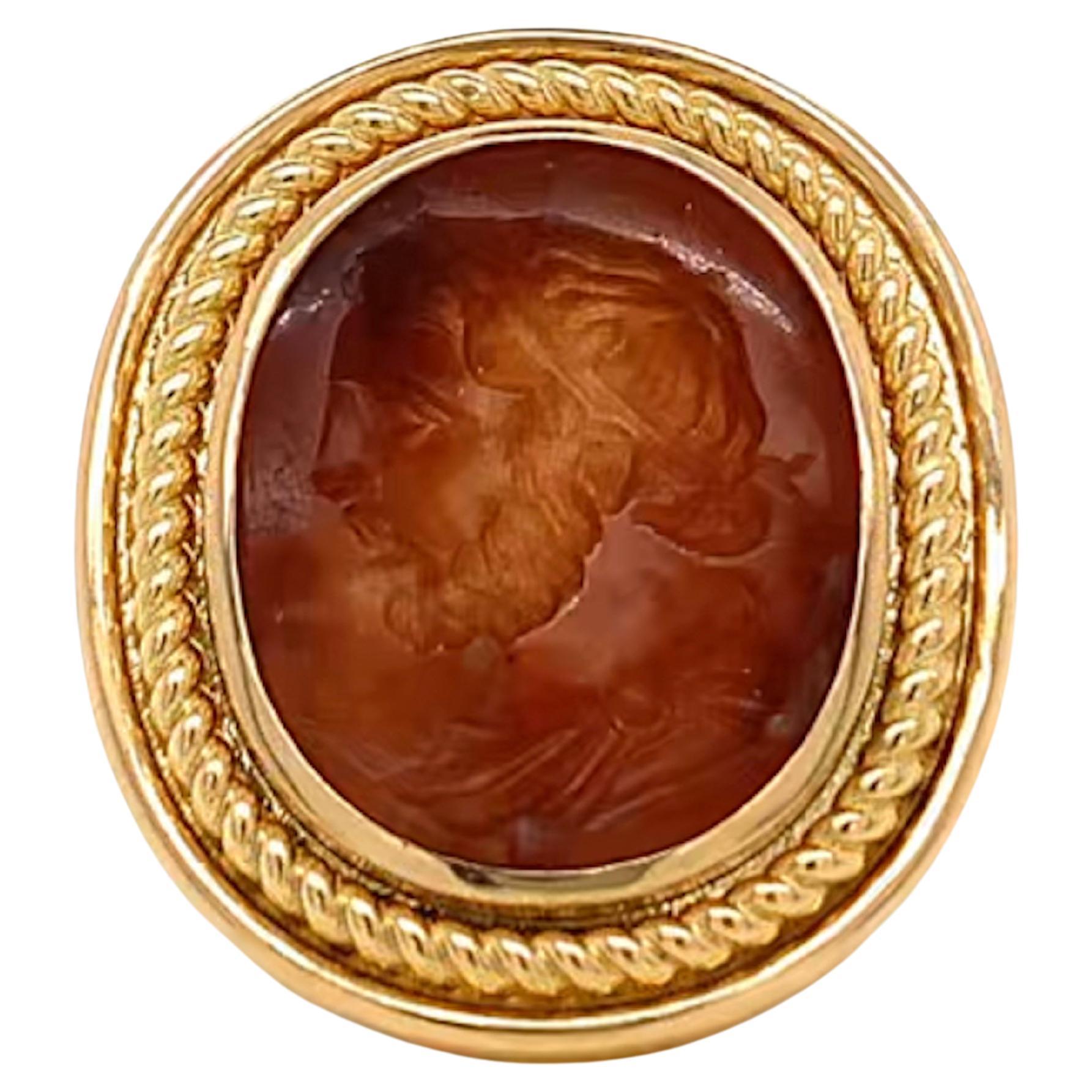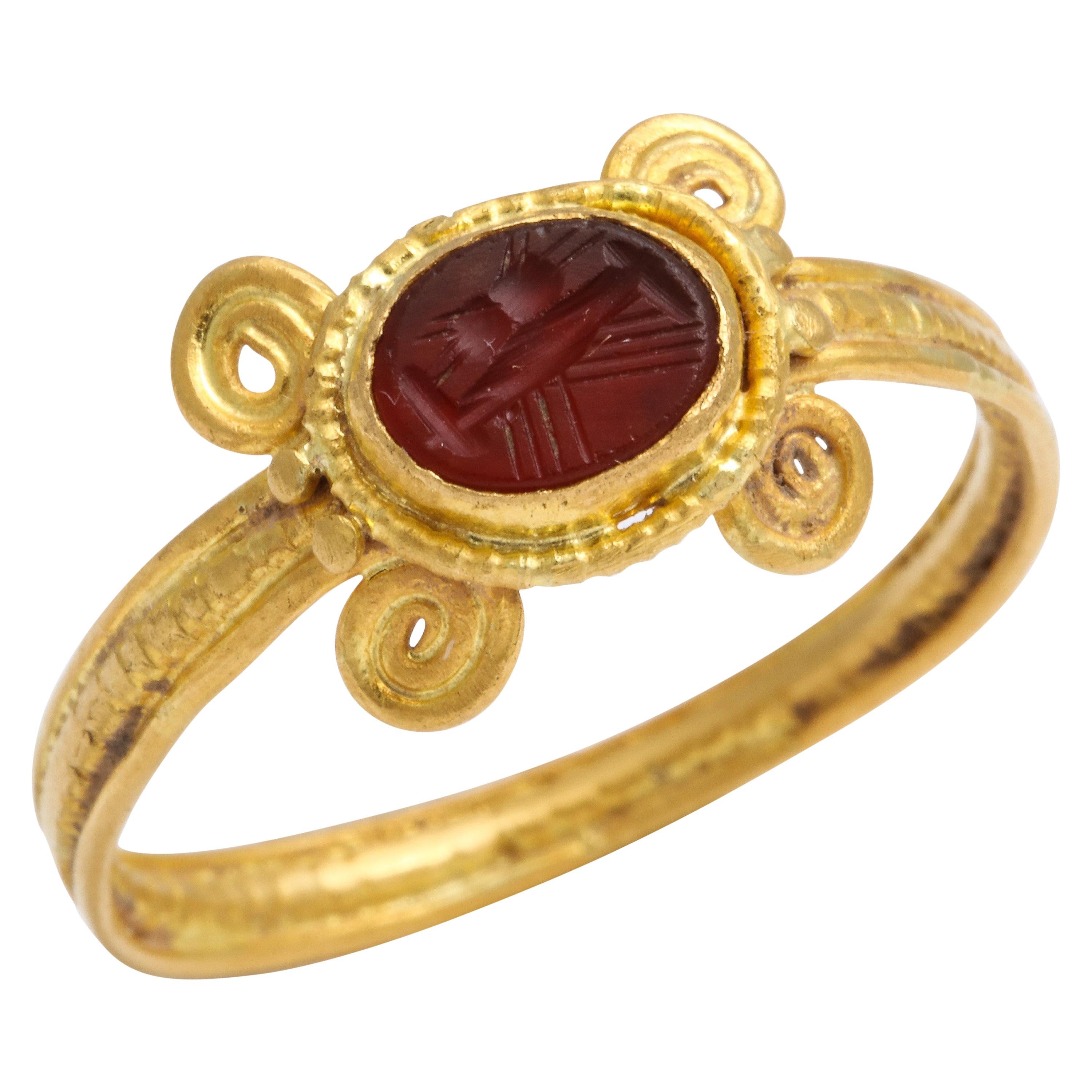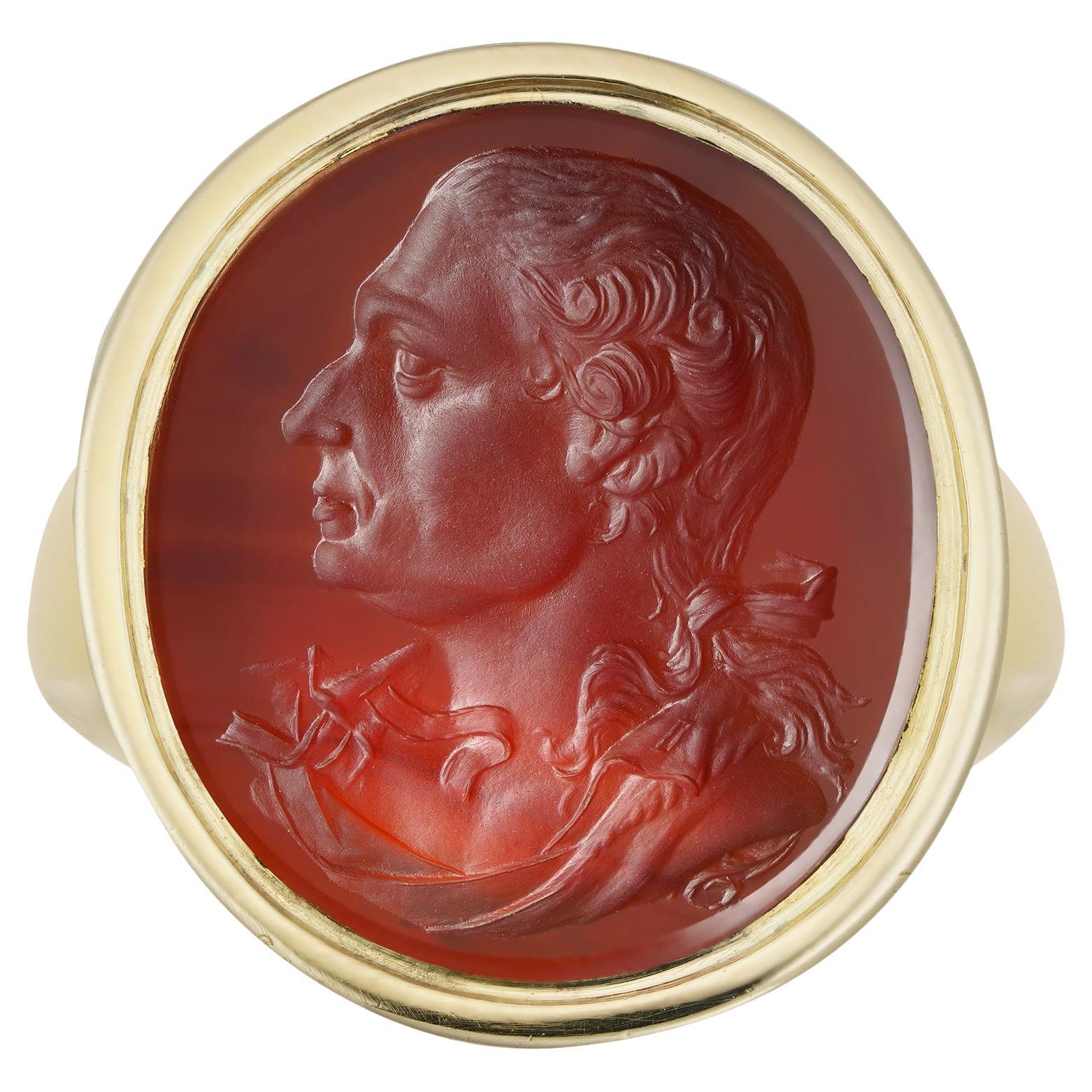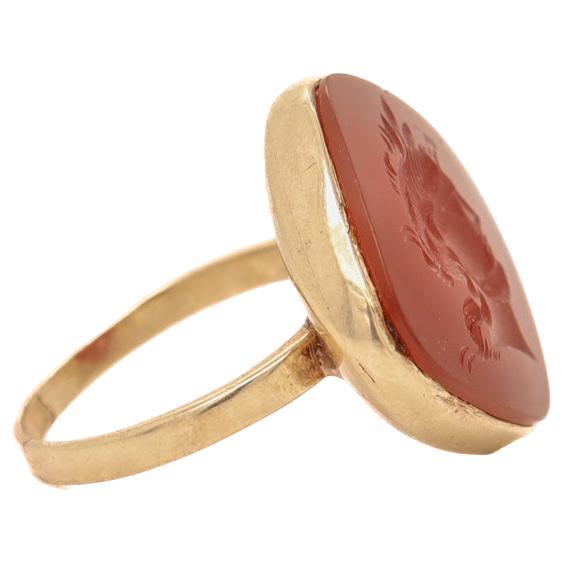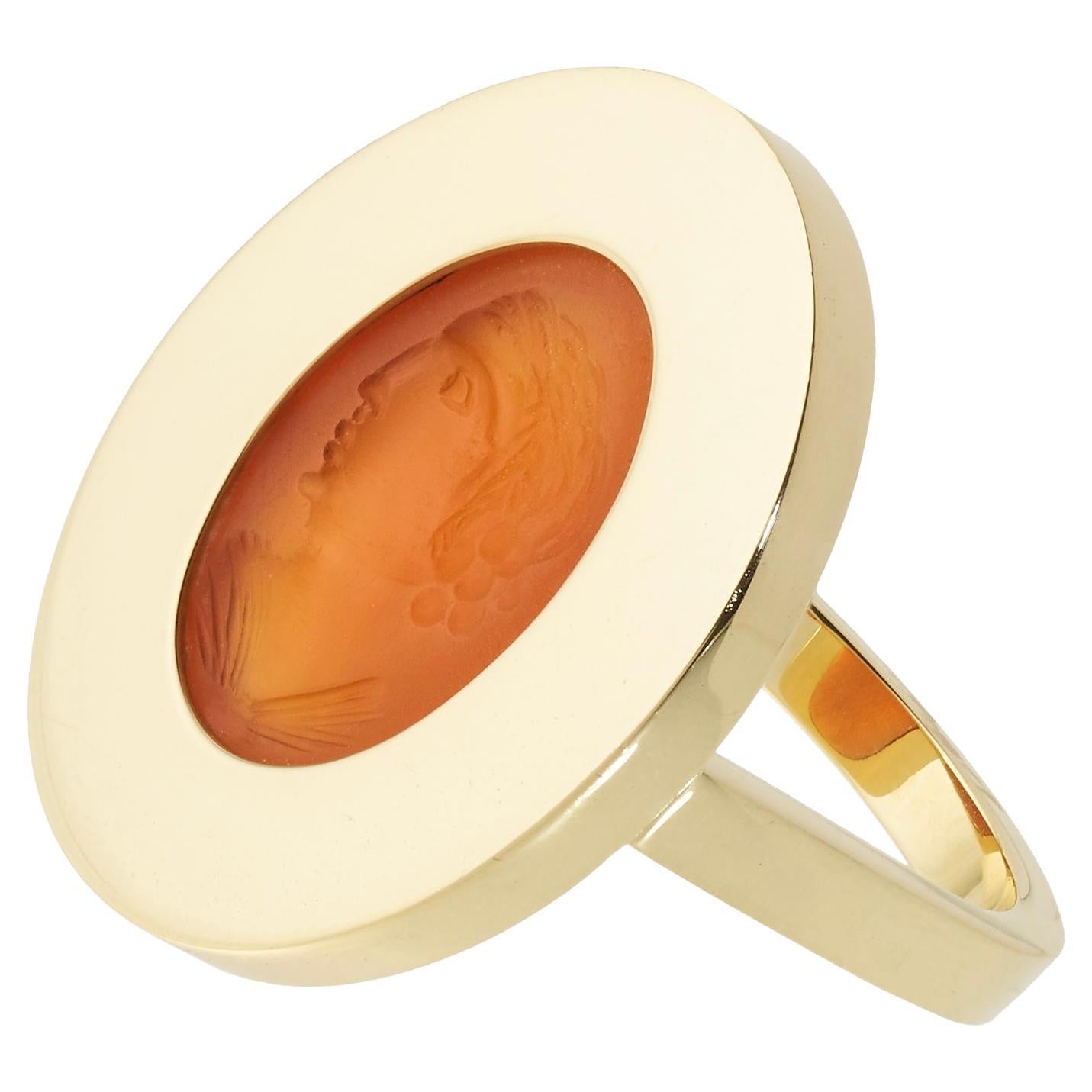Items Similar to Rare Ancient Egyptian Carved Carnelian Frog Amulet Swivel Ring 18th Dynasty
Want more images or videos?
Request additional images or videos from the seller
1 of 13
Rare Ancient Egyptian Carved Carnelian Frog Amulet Swivel Ring 18th Dynasty
About the Item
This rare Egyptian carved carnelian frog amulet dates to the Eighteenth Dynasty of the New Kingdom, circa 1300 BC. Frog amulets, depicting the goddess Heket, were commonly worn by both the living as a fertility charm and the dead to provide rejuvenation and a long afterlife.
The ancient amulet is pierced horizontally and set into a later gold swivel mount, probably dating from the late 19th century. The design of the gold mount inspired by rings worn by the ancient Egyptians and Etruscans with its swivel bezel and coiled wire on the shoulders.
The immense number of offspring made the frog an important symbol of fertility in ancient Egypt, and carved frog amulets were worn by women hoping for an easy delivery. This is exemplified with the goddess and protector of birth, Keket, who was depicted as a frog. After death, frog amulets would be placed within the wrappings of mummies, both men and women, in hope of a successful rebirth in the afterlife.
The association between this amphibian and rebirth may have been induced by the fact that every year, millions of frogs spontaneously appeared out of the river mud and filled the fields after the annual inundation of the Nile. This caused the Egyptians to believe that they spontaneously generated themselves out of the river mud. The influence of frogs in Ancient Egypt can be seen in the language, the hieroglyphic sign for "one hundred thousand" was a tadpole, and one of the Egyptian terms denoting "frogs" is whm-anx, meaning literally "they who repeat life."
Similar examples of ancient Egyptian carved stone frogs all date to the New Kingdom of Egypt (ca. 1550–1070 B.C.). The period known especially for monumental architecture and statuary honouring the gods and pharaohs, the New Kingdom, a period of nearly 500 years of political stability and economic prosperity, also produced an abundance of artistic masterpieces created for use by non-royal individuals.
The amulet rotates partially around the swivel mount. The ring is unmarked but tests as high-karat gold (20K gold / 21K gold). The dimensions of the amulet on its longest axes are: 2cm x 1.5cm x 0.8cm.
UK ring size H, US size 3.75
The ring weighs 5.57 grams.
Message us for images of museum references.
- Ring Size:3.75 US, Not Resizable
- Metal:
- Stone:
- Stone Cut:
- Weight:5.57 g
- Period:
- Date of Manufacture:1300BC
- Condition:
- Seller Location:London, GB
- Reference Number:1stDibs: LU2845221154002
About the Seller
5.0
Vetted Seller
These experienced sellers undergo a comprehensive evaluation by our team of in-house experts.
Established in 2019
1stDibs seller since 2022
32 sales on 1stDibs
Typical response time: 11 hours
- ShippingRetrieving quote...Ships From: London, United Kingdom
- Return PolicyA return for this item may be initiated within 14 days of delivery.
More From This SellerView All
- Small Ancient Indus Valley Bead Ring Etched Carnelian Cone Antique Gold RingLocated in London, GBA superb and rare ancient Indus Valley etched carnelian bead ring. The conical shaped carnelian gemstone in the centre dates from the middle of the third millennium BC. Deep orange in colour with white patterned etchings, these beads originate from the Indus Valley civilisation (parts of modern day Pakistan and India). These carnelian beads were alkaline-bleached to develop the geometric white patterns visible on the exterior. The technique was first developed by the Harappans of the Indus Valley civilisation, and vast quantities have been found in archaeological sites all across the Indus Valley. The conical stone has been set in a later high-karat gold ring mount, the hoop is hollow and of circular cross section which widens towards the bezel. This design and shape is typical of ancient gold rings...Category
Antique 18th Century Indian Signet Rings
MaterialsCarnelian, Gold
- Georgian 18th Century Signet Ring with Ancient Roman Nicolo Intaglio of HerculesLocated in London, GBA superb ancient Roman nicolo intaglio set in a late 18th century gold signet ring. Nicolo intaglios are a particular type of intaglio ma...Category
Antique Late 18th Century English Georgian Signet Rings
- Antique Italian 18th Century Georgian Gold Cameo Ring Bust of Medusa HardstoneLocated in London, GBA gorgeous 18th century Italian hardstone cameo ring. This beautiful four layered sardonyx cameo is carved from a single piece of agate with immense skill to reveal the bust of the G...Category
Antique Late 18th Century Italian Neoclassical Signet Rings
MaterialsAgate, Gold, 22k Gold
- Georgian Gold and Carnelian Signet Ring Large 19th Century Antique Seal RingLocated in London, GBA large antique English Georgian era gentleman’s gold signet ring, circa 1830. In the centre there is a flat-cut and bezel-set octagonal carneli...Category
Antique Early 19th Century British Georgian Signet Rings
MaterialsCarnelian, Gold
- Ancient Roman Carved Red Jasper Gryllus Signet Ring Antique GeorgianLocated in London, GBAn ancient Romano-British carved jasper intaglio dating from the 2nd to 3rd century AD, set in a later gold mount dating from the late 18th century. The intaglio is intricately carve...Category
Antique 15th Century and Earlier Italian Georgian Signet Rings
MaterialsJasper
- Ancient Roman Green Chalcedony Plasma Intaglio Ring of Goddess Victoria NikeLocated in London, GBA scarce ancient Roman intaglio dating from the 1st to 2nd century AD, depicting Victoria, the Roman Goddess of Victory (also known as Nike in Greek mythology). The cabochon gemstone is a chromium chalcedony, mottled green in colour. It was known in the ancient world as a ‘plasma’ stone and was widely used in jewellery and seals throughout the Roman Empire. However the mineral disappeared from use in the ancient world towards the end of the 2nd century AD when the known deposits were mined out. The intricate ancient engraving depicts a winged Victoria, draped and facing left, holding a palm branch in her right hand and a laurel leaf in her left. The green gem is translucent and contains small dotted black natural inclusions. The gemstone’s viridian green tones were linked to nature, growth, and prosperity, reflecting the Romans' appreciation for abundance and fertility. Victoria played a major part of Roman society, with many temples erected in her honour including one on the Palatine Hill which would house the spoils of war from Roman victories. She was, to the Romans, a symbol of victory over death, ultimately determining who would be successful during war. The high number of artistic and architectural dedications to her bear witness to the popularity of the goddess’ cult: Victoria widely appears on Roman coins...Category
Antique 15th Century and Earlier Italian Classical Roman Signet Rings
MaterialsChalcedony, 22k Gold
You May Also Like
- Ancient Egyptian Steatite Scarab Amulet 22K Yellow Gold Swivel Signet RingLocated in New York, NYAncient Egyptian steatite scarab amulet high carat gold swivel signet ring The Scarab ring design, also called a Scaraboid Seal, was developed as an...Category
Antique 15th Century and Earlier Unknown Egyptian Revival Signet Rings
MaterialsYellow Gold, 22k Gold
- Ancient Roman Carnelian Intaglio Ring with Clasped HandsLocated in Stamford, CTWe are proud to show this circular hoop of 22 Kt gold, with coiling around the shoulders, sets an oval shaped intaglio"dextrarum lunctio" on the carnelian. This translates to clasped...Category
Antique 15th Century and Earlier Italian Classical Roman Band Rings
MaterialsCarnelian, 22k Gold
- Castellani Ancient 7th Century Carnelian Intaglio 18kt Gold RingBy CastellaniLocated in New York, NYThe 7th century Roman intaglio is set into the Castellani® Artemis designed ring. The intaglio is set under the bezel, as jewellers did intaglio and cameo rings 2000 years ago. The g...Category
21st Century and Contemporary American Etruscan Revival Signet Rings
MaterialsCarnelian, Gold, 18k Gold
- An 18th C Carnelian Intaglio Of David Garrick As A RingLocated in London, GBA late 18th century carnelian intaglio mounted as a ring, the intaglio carved after the 1772 medal of Garrick by Lewis Pingo, 1743-1830, a cast of which is in the British Museum, Lo...Category
Antique Late 18th Century English Classical Roman Signet Rings
MaterialsCarnelian, 14k Gold, Yellow Gold
- Antique Gold & Carved Carnelian Intaglio Signet Ring with an Ancient Roman HeroLocated in Philadelphia, PAA fine antique intaglio ring. Likely converted from an antique button or pin. In 14k gold With a carved carnelian cabochon depicting an unidentified Roman hero. Marked 14k to the...Category
20th Century Etruscan Revival Signet Rings
MaterialsCarnelian, Gold
- Victoria Strigini: Ancient Roman Floating Cabochon Ring in 18k Gold & CarnelianLocated in New York, NYVictoria Strigini (b. 1991) A contemporary 18k yellow gold ring featuring an orange ancient Roman carnelian intaglio depicting a female’s bus...Category
Antique 15th Century and Earlier English Classical Roman Signet Rings
MaterialsCarnelian, 18k Gold
